Are Women More Vulnerable to Flooding Than Men in an Aging Japanese Society?
Abstract
1. Introduction
2. Materials and Methods
2.1. Case Selection
2.1.1. 1982 Case
2.1.2. 2018 Case
2.1.3. 2020 Case
3. Analysis and Results
3.1. For 1982
3.2. For 2018
3.3. For 2020
3.4. Framework Development
4. Conclusions
- In the 1980s, women were more vulnerable to water-related disasters than men, and the female fatality rate increased with age linearly and faster than men.
- Although the absolute number of water-related disaster victims in Japan in recent years was still higher for females than males, it is not evidence of women’s vulnerability but a reflection of the fact that there are more old women nowadays in Japan.
- Today, flood vulnerability in Japan is more driven by aging than gender. Such a change in flood vulnerability from gender-related to gender-neutral has not been reported up to now.
- The fatality rate in a recent flood disaster increased with age much faster for males than females.
- Moreover, the number of victims increased with age quadratically or exponentially in recent years.
- Finally, a new framework was proposed for assessing flood vulnerability in an aging society.
Author Contributions
Funding
Institutional Review Board Statement
Informed Consent Statement
Data Availability Statement
Acknowledgments
Conflicts of Interest
References
- Milly, P.; Wetherald, R.; Dunne, K.; Delworth, T. Increasing risk of great floods in a changing climate. Nature 2002, 415, 514–517. [Google Scholar] [CrossRef] [PubMed]
- Smiley, K.T.; Noy, I.; Wehner, M.F.; Frame, D.; Sampson, C.C.; Wing, O.E. Social inequalities in climate change-attributed impacts of Hurricane Harvey. Nat. Commun. 2022, 13, 3418. [Google Scholar] [CrossRef] [PubMed]
- Huang, X.; Swain, D.L. Climate change is increasing the risk of a California megaflood. Sci. Adv. 2022, 8, eabq0995. [Google Scholar] [CrossRef] [PubMed]
- Corringham, T.W.; McCarthy, J.; Shulgina, T.; Gershunov, A.; Cayan, D.R.; Ralph, F.M. Climate change contributions to future atmospheric river flood damages in the western United States. Sci. Rep. 2022, 12, 13747. [Google Scholar] [CrossRef] [PubMed]
- MLIT. Available online: https://www.mlit.go.jp/report/press/mizukokudo03_hh_001056.html (accessed on 1 October 2022).
- Cabinet Office. Available online: https://www.bousai.go.jp/updates/h30typhoon21/index.html (accessed on 1 October 2022).
- Kansai Airports. Available online: http://www.kansaiairports.co.jp/news/2018/2662/J181211_ReproducingMP_FloodingSituation.pdf (accessed on 1 October 2022).
- Ayeb-Karlsson, S. When the disaster strikes: Gendered (im)mobility in Bangladesh. Clim. Risk Manag. 2020, 29, 100237. [Google Scholar] [CrossRef]
- Hines, R.I. Natural Disasters and Gender Inequalities: The 2004 Tsunami and the Case of India. Race Gend. Class 2007, 14, 60–68. [Google Scholar]
- Neumayer, E.; Thomas Plümper, T. The Gendered Nature of Natural Disasters: The Impact of Catastrophic Events on the Gender Gap in Life Expectancy, 1981–2002. Ann. Assoc. Am. Geogr. 2007, 97, 551–566. [Google Scholar] [CrossRef]
- Petrucci, O.; Aceto, L.; Bianchi, C.; Bigot, V.; Brázdil, R.; Pereira, S.; Kahraman, A.; Kılıç, Ö.; Kotroni, V.; Llasat, M.C.; et al. Flood Fatalities in Europe, 1980–2018: Variability, Features, and Lessons to Learn. Water 2019, 11, 1682. [Google Scholar] [CrossRef]
- Stake, R.E. The Art of Case Study Research; SAGE Publications: Thousand Oaks, CA, USA, 1995. [Google Scholar]
- Ushiyama, M.; Honma, M.; Yokomaku, S.; Sugimura, K. Characteristics of victims caused by heavy rainfall disaster in July, 2018. J. JSNDS 2019, 38, 29–54. [Google Scholar]
- Takahashi, K. Lessons from 1982 Nagasaki Flood Disaster. Available online: https://core.ac.uk/display/58758577 (accessed on 15 September 2022).
- Cabinet Office, Japan. Available online: https://www.bousai.go.jp/kaigirep/hakusho/h31/honbun/0b_1s_01_01.html (accessed on 2 October 2022).
- MLIT. Report of Water-Related Disaster in 2018. Available online: https://www.mlit.go.jp/river/pamphlet_jirei/pdf/suigai2018.pdf (accessed on 5 October 2022).
- Kumamoto Prefecture. Available online: https://www.pref.kumamoto.jp/soshiki/98/72723.html (accessed on 5 October 2022).
- MLIT. Report of Water-Related Disaster in 2020. Available online: https://www.mlit.go.jp/river/pamphlet_jirei/pdf/suigai2020.pdf (accessed on 5 October 2022).
- Huang, G.; Fan, J. Current flood warning system in Japan and its effectiveness in mobilizing evacuation: Lessons from case studies. J. Emerg. Manag. 2023; in press. [Google Scholar]
- Matsuda, I.; Hanai, T.; Mochizuki, T. Damage caused by the Nagasaki heavy rain and the typhoon of 1982 and some problems on countermeasures. Compr. Urban Study 1984, 23, 107–115. [Google Scholar]
- NHK. Available online: https://www.nhk.or.jp/bunken/yoron-jikan/ (accessed on 10 October 2022).
- Wakabayashi, K.; Hanai, T.; Mochizuki, T. Psychological Effects of the 1982 Nagasaki Torrential Rain Disaster. Compr. Urban Study 1987, 30, 17–49. [Google Scholar]
- Asahi News Digital. Available online: https://www.asahi.com/articles/ASL795DVHL79PTIL02X.html (accessed on 1 October 2022).
- Ishizuka, Y.; Higashi, T. Reality and Issues of Persons need Supports for Evacuation during a Disaster—A Case Study of the town of Mabi in Kurashiki city affected by the 2018 Torrential Rains in Western Japan-. J. Jpn. Assoc. Incl. Soc. 2021, 23, 15–24. [Google Scholar]
- Liang, J.; Bennett, J.M.; Shaw, B.A.; Quiñones, A.R.; Ye, W.; Xu, X.; Ofstedal, M.B. Gender Differences in Functional Status in Middle and Older Age: Are There Any Age Variations? J. Gerontol. B Psychol. Sci. Soc. Sci. 2008, 63, S282–S292. [Google Scholar] [CrossRef] [PubMed]
- Sialino, L.D.; Picavet, H.S.J.; Wijnhoven, H.A.; Loyen, A.; Verschuren, W.M.; Visser, M.; Schaap, L.S.; van Oostrom, S.H. Exploring the difference between men and women in physical functioning: How do sociodemographic, lifestyle- and health-related determinants contribute? BMC Geriatr. 2022, 22, 610. [Google Scholar] [CrossRef]
- Bryant, E.C.; Trew, M.E.; Bruce, A.M.; Kuisma, R.M.; Smith, A.W. Gender differences in balance performance at the time of retirement. Clin. Biomech. 2005, 20, 330–335. [Google Scholar] [CrossRef]
- Ionescu, C.; Klein, R.J.T.; Hinkel, J.; Kumar, K.S.K.; Klein, R. Towards a formal framework of vulnerability to climate change. Environ. Model. Assess. 2009, 14, 1–16. [Google Scholar] [CrossRef]
- White, P.; Pelling, M.; Sen, K.; Seddon, D.; Russell, S.; Few, R.; Overseas Development Group. Disaster Risk Reduction. A Development Concern. DFID. 2005. Available online: https://www.unisdr.org/preventionweb/files/2065_VL108500.pdf (accessed on 10 October 2022).
- Rentschler, J.; Salhab, M.; Jafino, B.A. Flood exposure and poverty in 188 countries. Nat. Commun. 2022, 13, 3527. [Google Scholar] [CrossRef]
- Qiang, Y. Disparities of population exposed to flood hazards in the United States. J. Environ. Manag. 2019, 232, 295–304. [Google Scholar] [CrossRef]
- Bertsch, R.; Glenis, V.; Kilsby, C. Building level flood exposure analysis using a hydrodynamic model. Environ. Model. Softw. 2022, 156, 105490. [Google Scholar] [CrossRef]
- Goumrasa, A.; Guendouz, M.; Guettouche, M.S.; Belaroui, A. Flood hazard susceptibility assessment in Chiffa wadi watershed and along the first section of Algeria North–South highway using GIS and AHP method. Appl. Geomat. 2021, 13, 565–585. [Google Scholar] [CrossRef]
- Wang, Y.; Hong, H.; Chen, W.; Li, S.; Panahi, M.; Khosravi, K.; Shirzadi, A.; Shahabi, H.; Panahi, S.; Costache, R. Flood susceptibility mapping in Dingnan County (China) using adaptive neuro-fuzzy inference system with biogeography based optimization and imperialistic competitive algorithm. J. Environ. Manag. 2019, 247, 712–729. [Google Scholar] [CrossRef] [PubMed]
- Wang, T.; Yang, L.; Wu, S.; Gao, J.; Wei, B. Quantitative Assessment of Natural Disaster Coping Capacity: An Application for Typhoons. Sustainability 2020, 12, 5949. [Google Scholar] [CrossRef]
- Pearson, J.D.; Morrell, C.H.; Gordon-Salant, S.; Brant, L.J.; Metter, E.J.; Klein, L.L.; Fozard, J.L. Gender differences in a longitudinal study of age-associated hearing loss. J. Acoust. Soc. Am. 1995, 97, 1196–1205. [Google Scholar] [CrossRef] [PubMed]
- Ministry of Health, Labor and Welfare, Japan. Comprehensive Survey of Living Conditions. 2021. Available online: https://www.mhlw.go.jp/toukei/saikin/hw/k-tyosa/k-tyosa21/index.html (accessed on 2 October 2022).
- McCarthy, J.; Canziani, O.; Leary, N.; Dokken, D.; White, K. (Eds.) Climate change 2001: Impacts, adaptation and vulnerability. In Contribution of Working Group II to the Third Assessment Report of the Intergovernmental Panel on Climate Change; Cambridge University Press: Cambridge, UK, 2001. [Google Scholar]
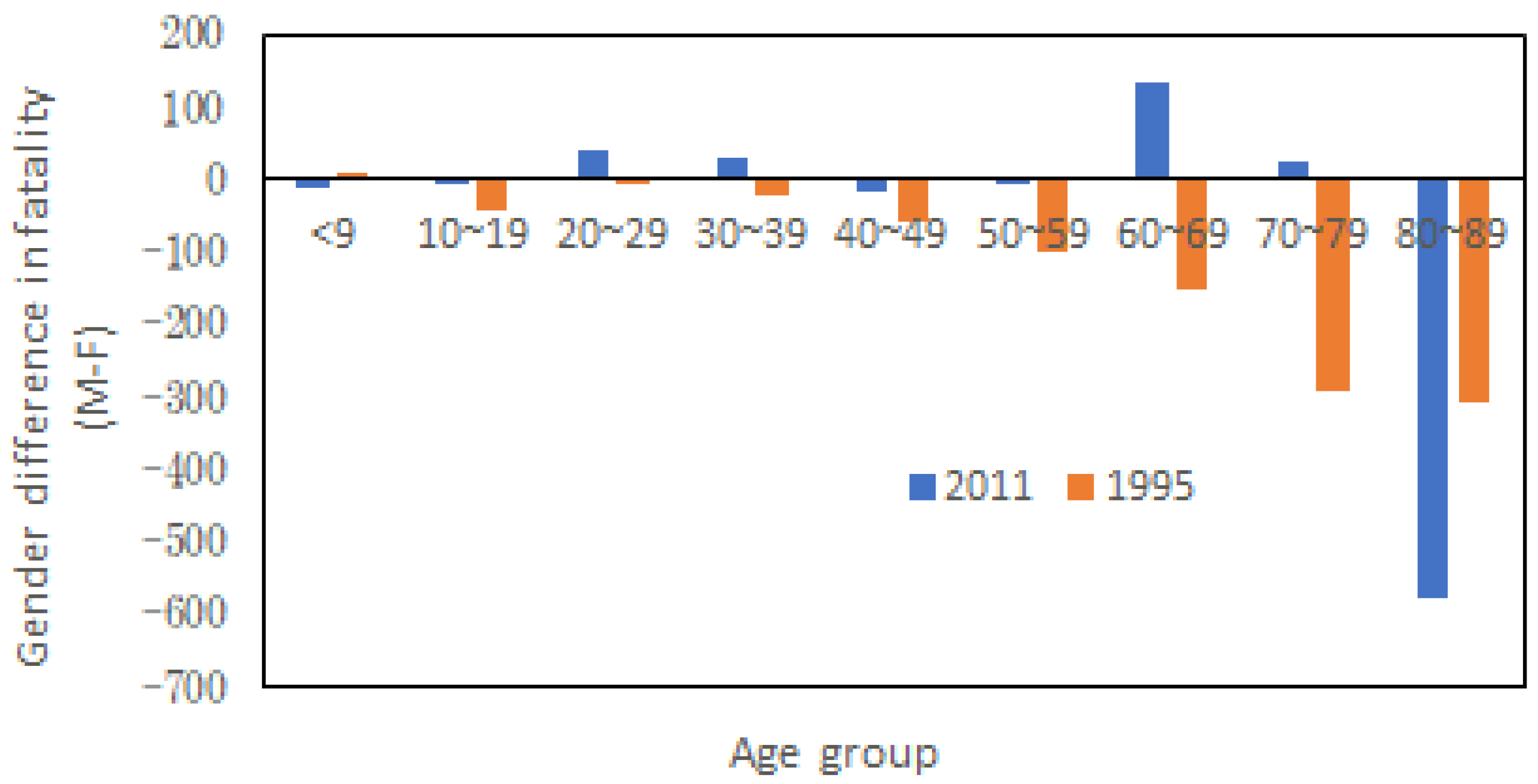
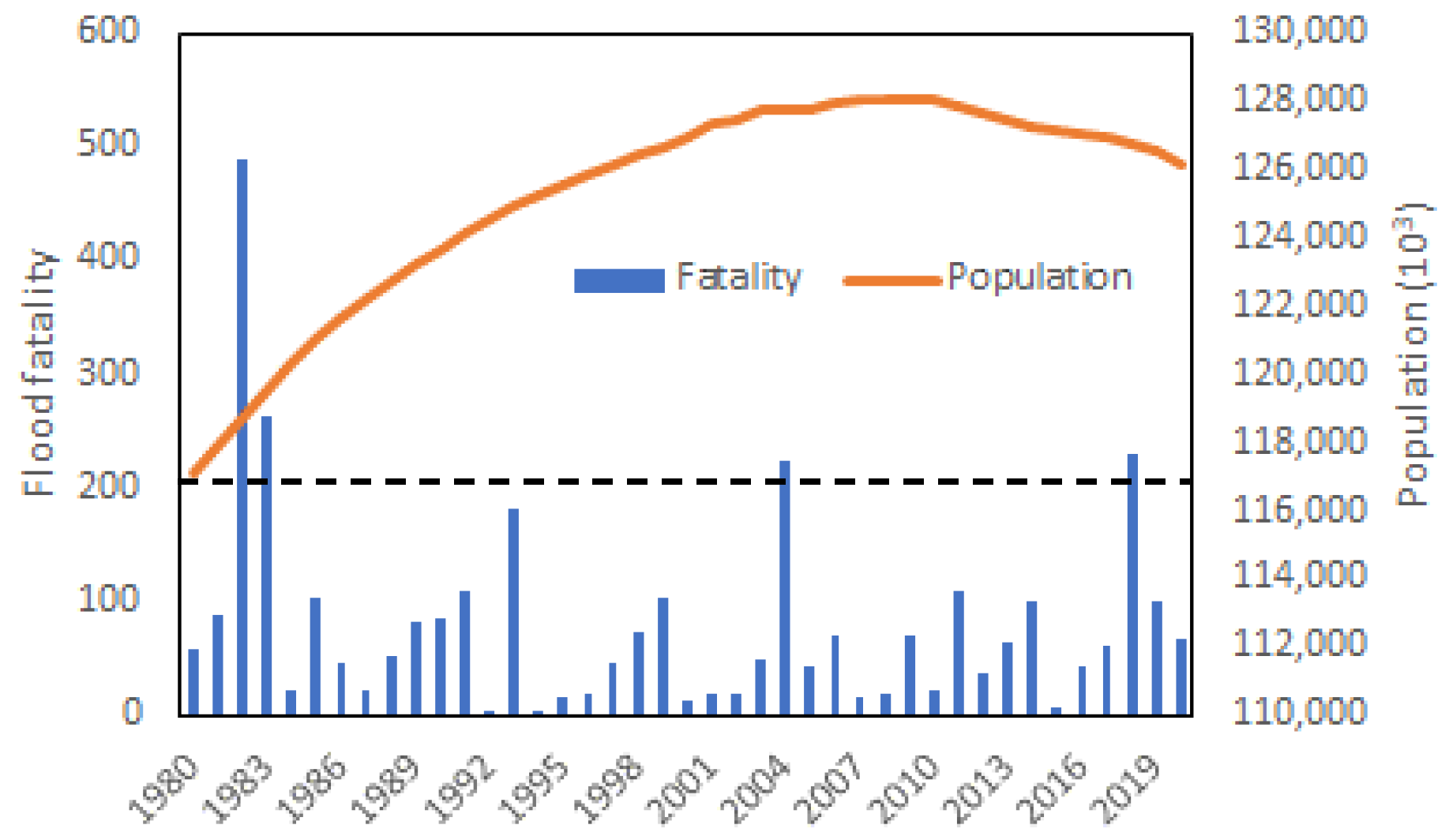
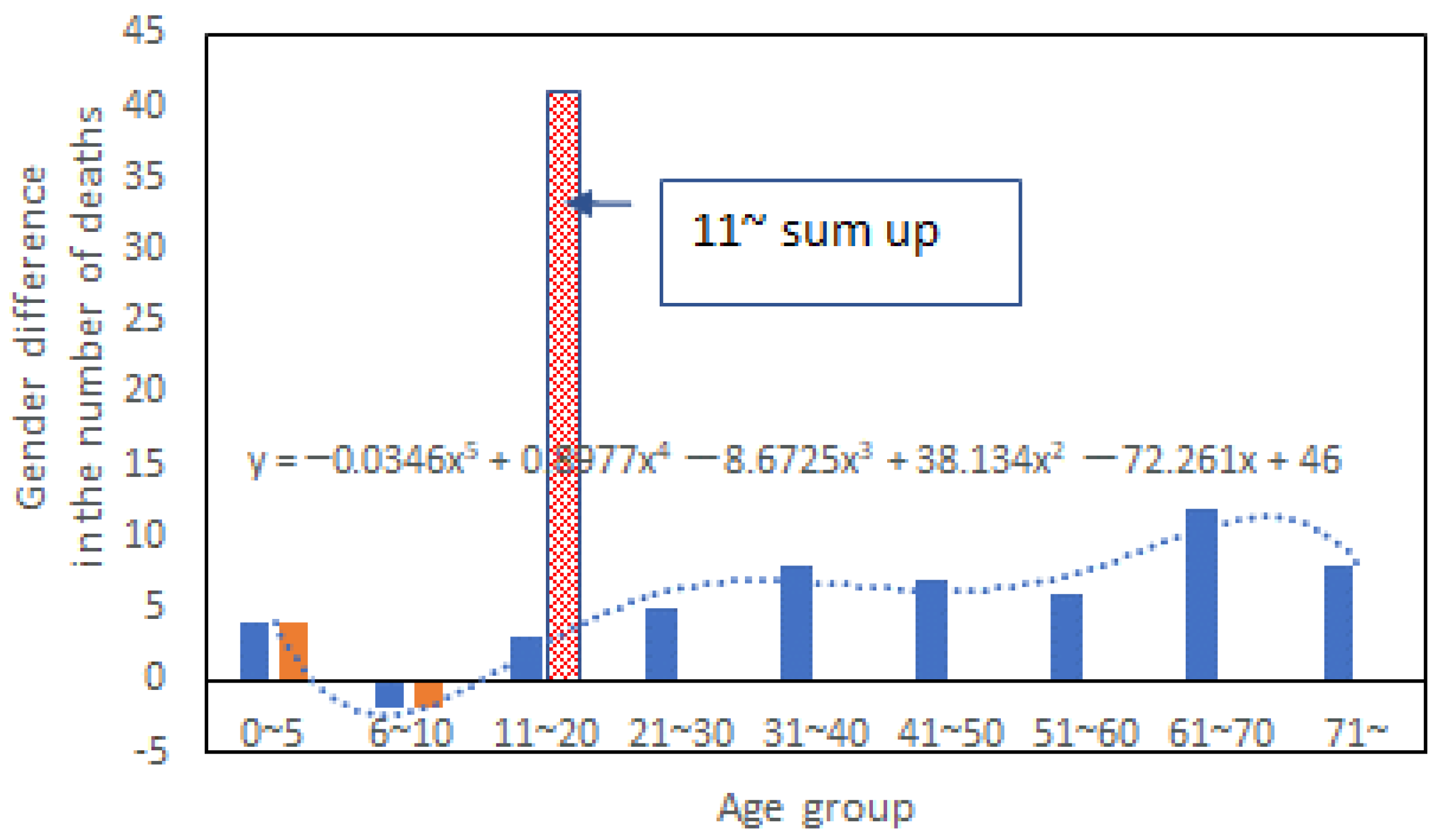
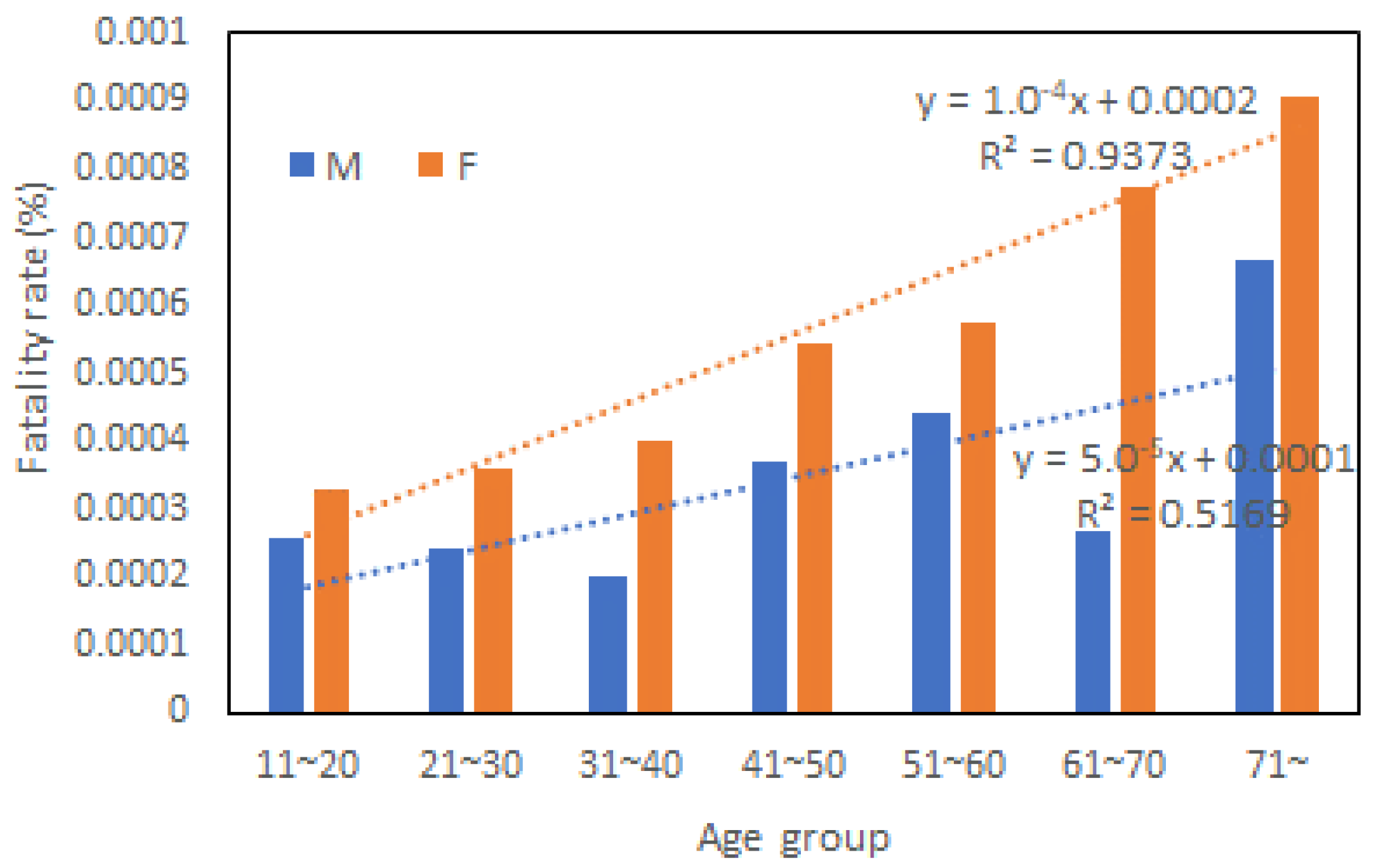
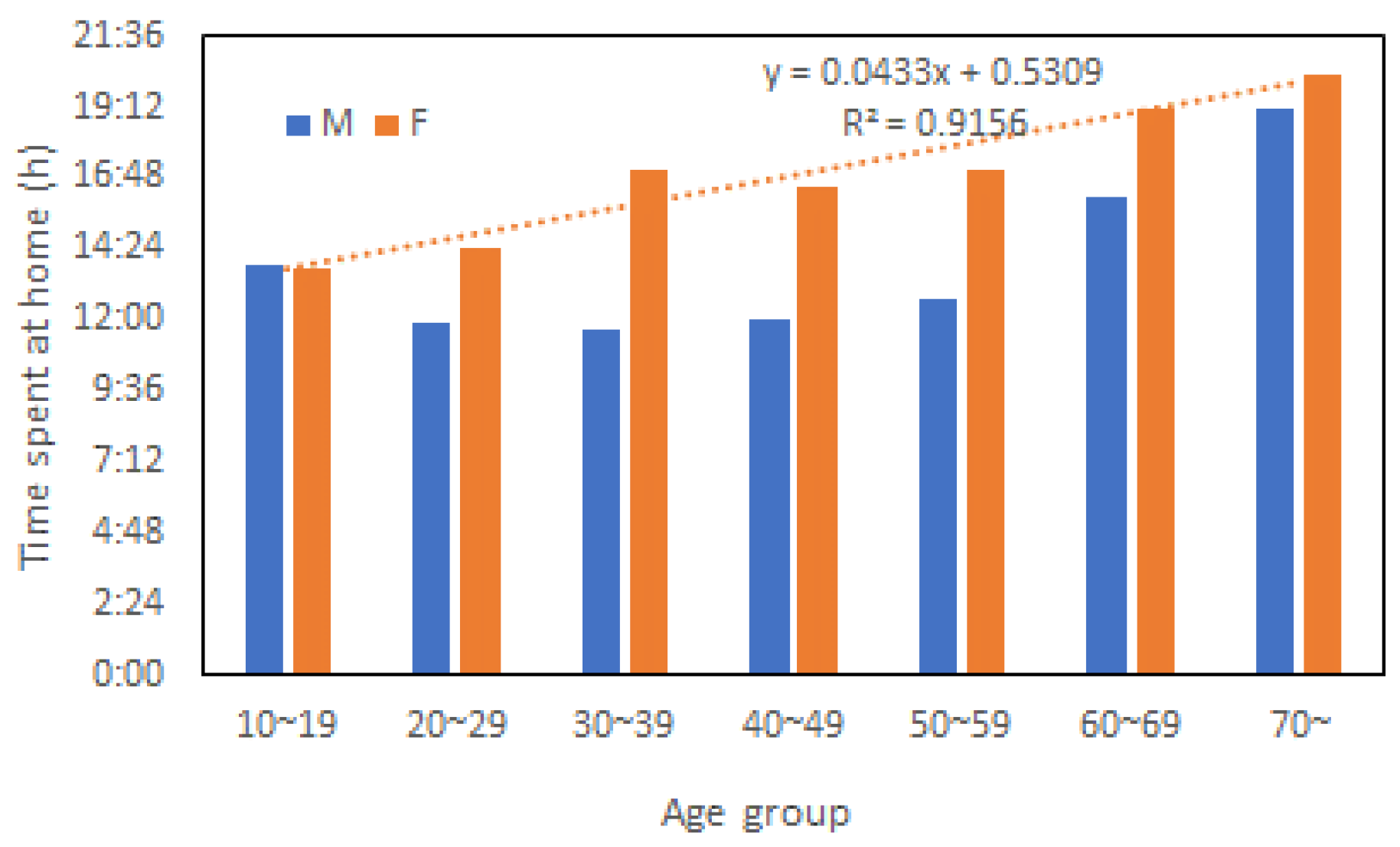
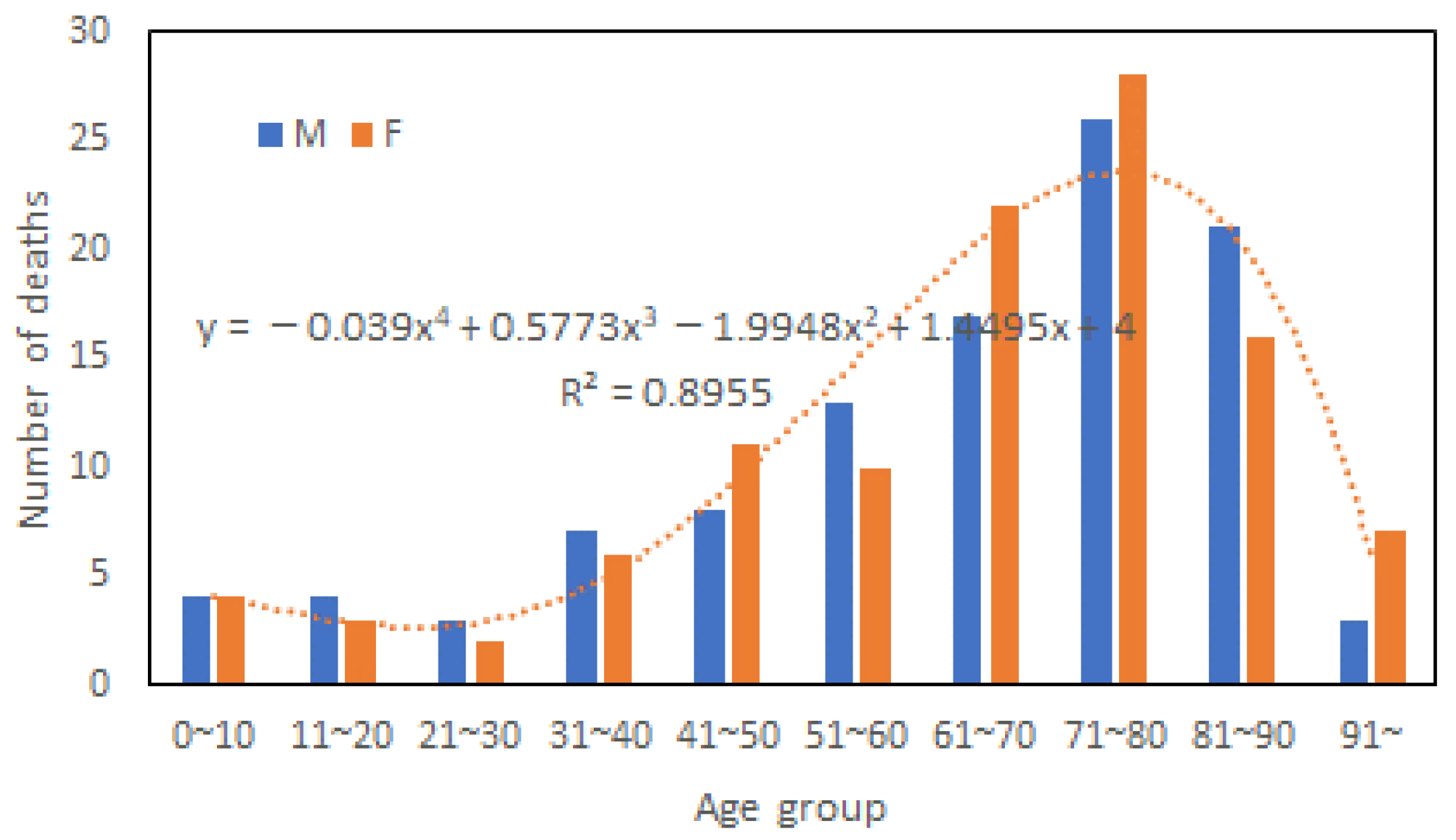
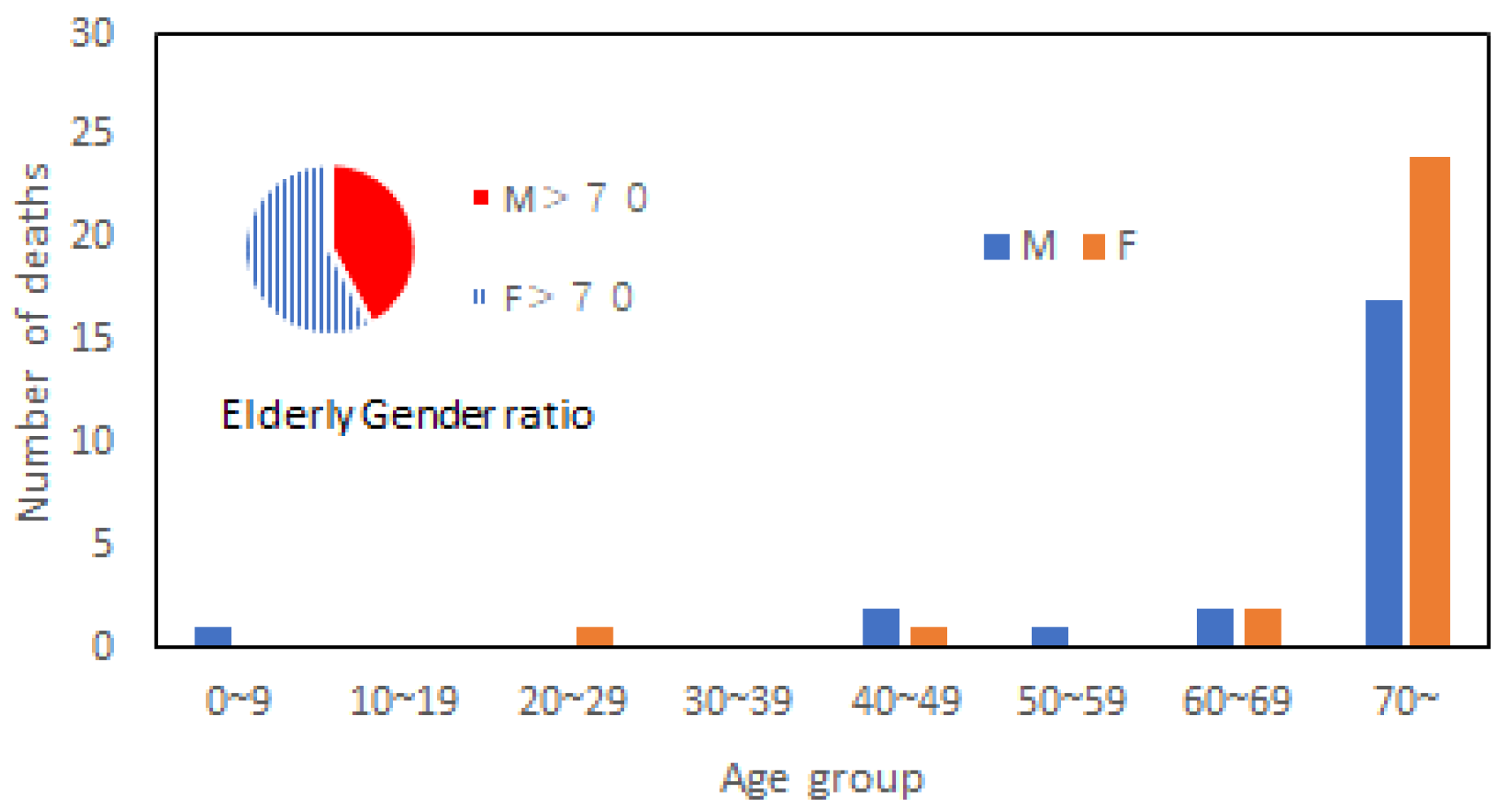

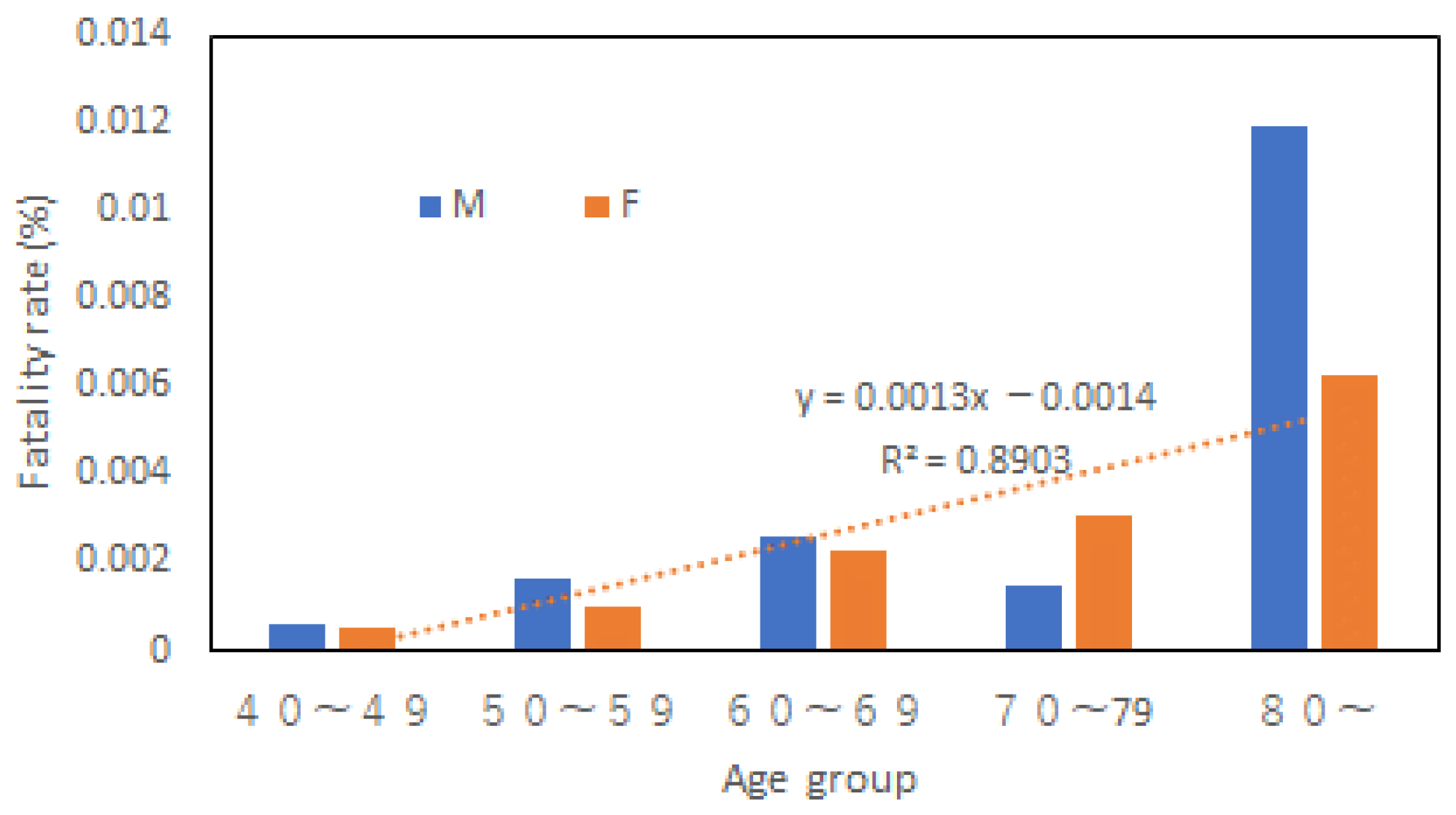

Disclaimer/Publisher’s Note: The statements, opinions and data contained in all publications are solely those of the individual author(s) and contributor(s) and not of MDPI and/or the editor(s). MDPI and/or the editor(s) disclaim responsibility for any injury to people or property resulting from any ideas, methods, instructions or products referred to in the content. |
© 2023 by the authors. Licensee MDPI, Basel, Switzerland. This article is an open access article distributed under the terms and conditions of the Creative Commons Attribution (CC BY) license (https://creativecommons.org/licenses/by/4.0/).
Share and Cite
Fan, J.; Huang, G. Are Women More Vulnerable to Flooding Than Men in an Aging Japanese Society? Int. J. Environ. Res. Public Health 2023, 20, 1299. https://doi.org/10.3390/ijerph20021299
Fan J, Huang G. Are Women More Vulnerable to Flooding Than Men in an Aging Japanese Society? International Journal of Environmental Research and Public Health. 2023; 20(2):1299. https://doi.org/10.3390/ijerph20021299
Chicago/Turabian StyleFan, Juan, and Guangwei Huang. 2023. "Are Women More Vulnerable to Flooding Than Men in an Aging Japanese Society?" International Journal of Environmental Research and Public Health 20, no. 2: 1299. https://doi.org/10.3390/ijerph20021299
APA StyleFan, J., & Huang, G. (2023). Are Women More Vulnerable to Flooding Than Men in an Aging Japanese Society? International Journal of Environmental Research and Public Health, 20(2), 1299. https://doi.org/10.3390/ijerph20021299






